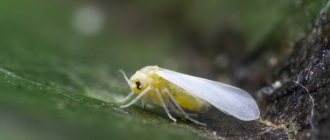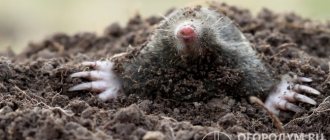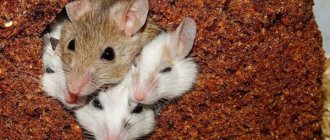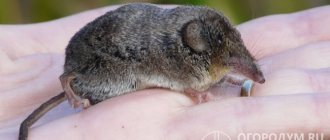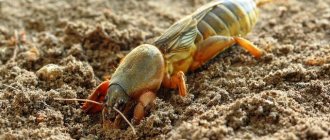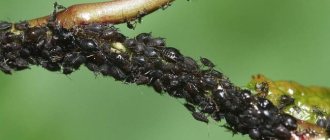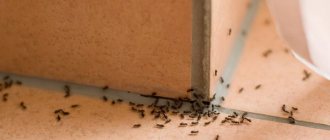21.08.2019
The appearance of this inconspicuous pest poses a serious threat to cabbage plantings. The cabbage white butterfly is widespread throughout Russia, multiplies quickly and willingly feasts on other plantings of cultivated plants. Fortunately, experienced gardeners have developed many methods to combat this nasty pest. The following review will tell you how to treat plantings to kill caterpillars and how to protect cabbage from the cabbage butterfly.
- Why do cabbage plants appear, what harm do they cause?
- Saving cabbage from insect invasion
- Tips and tricks
Who is she - the storm of vegetable gardens?
Some novice summer residents do not know what cabbage looks like, but you need to know the enemy by sight.
Then it will be clear who the fight will be with. The second name of this pest is cabbage white. Indeed, this butterfly has light wings, but they have minor black inclusions. Females have a more pronounced dark pattern on their wings and are larger than their partners. Female representatives of this species have a forewing length of 27-33 mm, and males - 25-30 mm.
Of course, they lay eggs, from which voracious female caterpillars then hatch. Therefore, representatives of this sex are the most dangerous for crops.
One female can lay up to 300 lemon-yellow eggs. The clutches are located on the back of the leaves. After 3-16 days, voracious caterpillars hatch, quickly increase in size and begin their destructive activities.
Botanical description of the pest
The pest belongs to the white butterfly family. The external features of the small insect are as follows:
- Body structure: dark body, white wings with black spots. Size about 2–3 cm.
- The wingspan of females reaches 6 cm, while that of males is slightly smaller.
- Butterfly caterpillars are blue-greenish in color with three yellow stripes and black dots on the back.
- The 2.5 cm pupa is yellow-green in color and has gray-brown spots on it. It is entwined with a silky thread, with which it holds onto the leaf of the plant.
- The butterfly has well-developed visual organs, as well as a keen sense of smell. The front legs and club-like thickenings on the antennae serve as organs of touch.
What plants does he like?
Although this butterfly is called that, it loves to feast on more than just cabbage.
Here are the plants that the whiteweed affects:
- horseradish;
- rutabaga;
- gray hiccup;
- shepherd's purse;
- radish;
- capers;
- turnip;
- garden and field cabbage;
- turnip;
- dyeing weed;
- some types of flowers.
Plants are pestered by voracious caterpillars, which in a short time can eat most of the leaves. Butterflies are harmful only because they lay numerous offspring. There are also benefits in whites. Fluttering from flower to flower, cabbage carries pollen, thereby pollinating plants.
But it is necessary to implement timely measures to combat this pest. These methods can be:
- mechanical;
- folk;
- attracting beneficial insects;
- in the form of life hacks;
- chemical.
Biological protection
The safest method of destroying cabbage caterpillars is to attract its natural enemies to the garden bed: insects and birds. If the garden exudes the smell of herbs, ladybugs and beetles will fly to it. They are guaranteed to destroy caterpillars and aphids, leaving the plants intact.
Attracting birds to your garden is an effective way to protect your cabbage from pests. Build birdhouses and feed the birds regularly. Wasps and ants are excellent hunters, feasting on caterpillars. These insects feed their larvae with them. To attract them to the beds, water the cabbage with honey or sugar solution.
Advice! It is recommended to use Bitoxibacillin, a biological agent that protects against whites. It contains exotoxin and bacterial spores. Take 100 g of the substance into a bucket of water and mix thoroughly. To increase the stickiness of the solution, it is advisable to add dry milk (a couple of tablespoons is enough). Apply the prepared suspension to the leaves when the weather is dry. After a week, repeat the treatment. The drug is completely non-toxic.
Mechanical methods of control
One cabbage butterfly is capable of breeding 2-3 generations of caterpillars per season. With the onset of warm spring days, you can already see white moths flying. At the beginning of summer, caterpillars hatch from the laid eggs, which then grow into butterflies. They will give rise to another generation of pests.
The caterpillars that pupate at the end of summer - beginning of autumn overwinter in the cracks of buildings and houses. They may also be located under the bark. To prevent pests from overwintering here, farmers whiten trees at the end of autumn. At the same time you need to inspect the bark. If you notice cabbage butterfly pupae here, you need to remove and destroy them.
The next mechanical method is used at the beginning of summer. It is necessary to periodically inspect the underside of the leaves, and if a clutch of eggs or caterpillars is found, they are destroyed.
Expert opinion
Mityuk Stefania Bogdanovna
I try not to use “chemicals” in my garden. Previously, I offered children such entertainment - catching cabbage butterflies with nets. And the kids are happy about this activity, and most of the pests were neutralized using this mechanical method.
Harm of the cabbage butterfly
The butterfly itself is not harmful - it is engaged in pollination. The harvest destroys its offspring, which feed mainly on the pulp of the leaves. The thick cabbage veins are left untouched. One caterpillar easily and quickly copes with a leaf in literally 2-3 hours!
The pest also pays attention to other representatives of the cruciferous family. Radishes, horseradish, and turnips are eaten first. Cabbage plants are happy to eat turnips, rutabaga, and even leftovers.
Contrary to popular belief, the cabbage plant does not lay eggs on raspberries. During the pupation process, the caterpillar attaches itself to the bark of trees, stumps, and the bottom of wooden fences. It is almost impossible to detect eggs or larvae.
The secretions produced by the caterpillar's glands can trigger allergic reactions on human skin. Therefore, when carrying out preventive work, protective equipment should not be neglected.
Beneficial insects
Some small gardeners are able to help a person cope with cabbage.
Not everyone knows that wasps can be useful to a gardener. These insects feed their young, including cabbage caterpillars. One wasp can carry up to 6 caterpillars to its nest per day.
The ichneumon ichneumon lays eggs in the caterpillar.
Therefore, before destroying a wasp’s nest, think about perhaps placing a cabbage bed nearby, but away from residential buildings.
There are other insect predators that can cope with cabbage offspring. For example, riders lay their eggs in caterpillars or larvae, piercing them with their sting. When the ichneumon ichneumon larva hatches, it will suck all the juices out of the insect it contains.
Therefore, if riders live on your site, do not destroy them, do not poison them with “chemicals”. In appearance, these insects are similar to wasps, but with a more elongated pelvis. Their larvae are oblong and white.
It will also be useful for garden crops if Trichogramma live on the site. These small insects, only 1 mm long, lay their offspring in the eggs of pests. In this way, they can also destroy the whitefish larvae in the bud.
Cabbage fly: how to detect and fight
Depending on the period of activity, spring and summer cabbage flies are distinguished. The spring one flies out of cover during the flowering period of birch and dandelion, and lays eggs en masse when the lilac blooms. The second wave begins at the end of June, but now the pest is terrible only for late cabbage, since, like flea beetles, it can greatly harm only young and still weak plants.
The cabbage fly is similar to the regular fly, but has a slightly different color
The insect looks like an ordinary fly, but is slightly smaller in size - 6–8 mm. If you look closely, you can find stripes on the abdomen and back. Cabbage is damaged by larvae. The female lays eggs on a stem close to the ground. The born larvae begin to feed on the roots, gnaw through the stem, and penetrate inside it. Unfortunately, pests are more often found on infected cabbage. Newly planted seedlings lie down as if they were broken or look lethargic, but watering does not help.
The whole fight comes down to prevention, and this is very good. After all, the less chemicals we use when growing cabbage, the healthier this vegetable is. There are some tips:
- Maintain crop rotation. The larvae overwinter in cabbage beds; as the weather warms up, they need to feed. By planting cabbage seedlings again in the same place, you will provide this nutrition.
- In autumn, after the temperature drops to +5... +10 ⁰C, dig up the ground. This will destroy wintering sites. The pests are already sleeping, cannot hide and are freezing out. There is a negative side - along with harmful insects, beneficial ones, such as earthworms, end up on the surface and die.
- Before planting cabbage, add Zemlin, Pochin, Grom or another preparation against soil pests to the soil. They need to be distributed evenly over the surface of the bed and mixed with the top layer of soil.
- Immediately after planting the seedlings, place a sheet of thick paper on each plant, cutting a hole in it the diameter of the stem. The leaf should fit snugly to the ground and plant. The cabbage fly will not be able to get to the egg laying site.
A simple and effective remedy for cabbage flies - a sheet of paper with a slot for the stem
Interesting life hacks
Popular thought is not asleep, and such research is supported by famous farmers of the country.
The famous garden designer and TV presenter Olga Platonova advises sticking sticks with washed egg shells on the tops next to the cabbage. Flying over these devices, the cabbage butterfly will think that another of its fellow tribesmen is laying eggs in this area, and will not touch the planting.
What means do you use to combat cabbage?
ChemicalFolk
Reputable gardeners also advise covering slightly grown cabbage with low-density white non-woven material or a mesh with small cells. Then not only the whitefish, but also other pests will not be able to penetrate here. In the same way, you can save cabbage from other pests.
Some lay out boards between the rows of plantings, and when caterpillars crawl under them in the heat, they collect and destroy the pests.
Expert opinion
Mityuk Stefania Bogdanovna
Gardeners also plant next to plants that are annoyed by whites, onions, garlic, and marigolds. The smell of these crops will repel pests, and you will receive additional decorations in the form of flowers, and you will be able to compact the plantings by growing onions and garlic here.
Causes and signs of white blight on cabbage
As soon as the butterfly begins to fly over the cabbage, this is a reason to inspect the plant and begin to fight the cabbage butterfly. There is no substantiated reason for this cabbage invasion. It has been noticed that the white butterfly is activated in hot and dry warm weather. Rainy weather has a detrimental effect on it.
This pest can be identified by the following signs:
- damage to cabbage leaves - they begin to turn yellow, dry out, lose their elasticity, and pinholes appear;
- the growth of the head of cabbage stops;
- caterpillars appear.
Chemical control agents
If the cabbage butterfly invasion has become widespread, and you have a lot of plantings that need to be protected, then you can use insecticides. But you must act strictly according to the instructions so as not to harm the plants and yourself.
One of the most effective means is “Senpai KE”. It is designed to combat leaf-eating insects at all stages of pest development.
This drug is sold in ampoules. 5 ml of the product are diluted in 5 liters of water, sprayed with this amount of solution 100 sq. m. landing. The effect of the solution will begin to appear after 30-120 minutes. After the destruction of these eggs, caterpillars, cabbage butterflies will fly around the treated area for another two weeks
The drug "Iskra M" is time-tested. It also has a long spectrum of action and fights various pests. To prepare a solution against whites, you need to dilute a 5 ml ampoule in 5 liters of water. This amount of working solution is enough to treat 50 square meters. m. landing.
When using these tools, you need to:
- carry out spraying in calm, dry weather;
- the gardener should wear a protective mask, goggles, and gloves;
- Process for the last time no later than 20 days before harvest.
Cruciferous flea beetles: how dangerous the pest is, prevention and control
Small (3–5 mm) black bugs are so named for their love of cruciferous plants and their ability to jump. They begin their active activity when the air temperature rises to +15 ⁰C and above. The larvae live in the ground and feed on roots! Adults actively eat succulent leaves. First, they settle on wild plants or green manure: rapeseed, mustard, shepherd's purse. When radishes appear in the beds, a whole colony switches to them and can be destroyed already at the cotyledon stage. The next treat we plant for cruciferous flea beetles is cabbage. The seedlings do not have time to take root, and all its leaves already look like a sieve. The worst thing is that pests can destroy it entirely.
Cruciferous flea beetles destroy plants already at the cotyledon stage
Cruciferous flea beetles are very annoying insects; they appear in my garden every year. But it’s easy to fight them, even if there are already a lot of them. Therefore, I will not recommend many folk remedies against this pest. I’ll only tell you about my proven and very simple method:
- As soon as my cabbage is on the plot, I water it with clean water and dust the wet leaves and soil with ash, tobacco dust, or a mixture of both.
- When this protection is washed away by rain or blown away by the wind, I renew it.
- At the same time, I give the young plants good care so that they grow faster. Flea beetles are no longer scary for mature cabbage. I water, loosen, feed.
Only fresh ash or stored for no more than one year in a closed container and in a dry room helps against fleas, aphids, and slugs. If you have collected ash from a fire or barbecue that has been exposed to rain, then you can only use it as a loosening material. Such ash no longer contains microelements useful for plants and does not have an alkaline reaction dangerous for insects.
I think that every garden plot can have wood or plant ash. You don’t need anything else to fight fleas. The product works well even without tobacco dust.
I only used chemicals against these pests once, but then I had real armageddon. I became interested in green manure and sowed the plot with rapeseed. He was completely covered with hordes of cruciferous flea beetles. When I cut down this green manure and planted cultivated plants, insects, of course, moved on to them. They ate everything: even dill and tomatoes! That’s when we had to spray literally all the crops with Karbofos (60 g per 10 liters of water), and a week later the treatment was repeated. I have been familiar with this drug for many years, and it has never let me down. This was in early June, so by harvest the insecticide had already completely decomposed. But I won’t conduct such experiments anymore. It’s better not to invite pests from all over the area into your garden, but to fight the small local detachment with the help of ash.
Preventative work
Experienced gardeners recommend the following preventive measures against whiteweed:
- regularly at the very beginning of the season it is necessary to destroy all weeds in the garden, since butterflies lay eggs on them in early spring;
- perform a daily inspection of the lower part of the leaves, scrupulously collecting all the laid white eggs;
- to reduce the pest population, it is advisable to dig up the garden in the fall;
- before winter you need to carefully check the bark of trees, find and destroy caterpillar pupae;
- It is advisable to plant cabbage seedlings early, while the butterflies are not yet flying en masse;
- You can’t plant cabbage next to mustard, horseradish, and radishes;
- when the bed is small, you can cover it with a plastic mesh that allows the sun's rays to pass through, but does not allow the leaves to come into contact with the butterflies.
